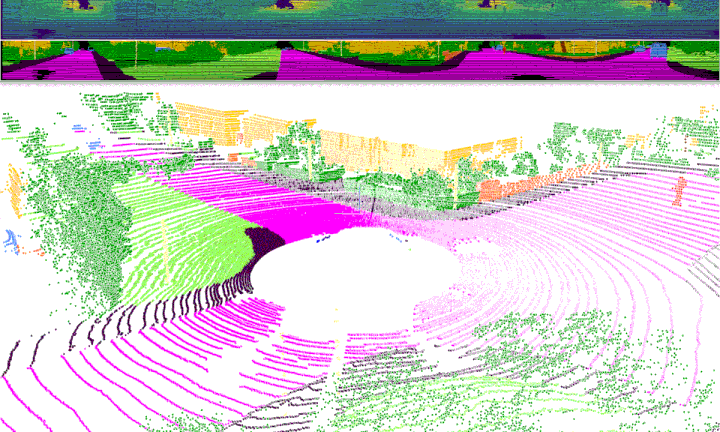Geometric Flow Network 
This is the Pytorch implementation of our following paper:
GFNet: Geometric Flow Network for 3D Point Cloud Semantic Segmentation
Haibo Qiu, Baosheng Yu and Dacheng TaoAbstract
Point cloud semantic segmentation from multiple projected views, such as range-view (RV) and bird's-eye-view (BEV), has been intensively investigated. Different views capture different information of point clouds and thus complementary to each other. However, recent projection-based methods usually utilize a vanilla late fusion strategy for predictions of different views, failing to explore the complementary information from a geometric perspective during representation learning. In this paper, we introduce a geometric flow network (GFNet) to explore the geometric correspondence between different views in an align-before-fuse manner. Specifically, we devise a novel geometric flow module (GFM) to bidirectionally align and propagate the complementary information between different views according to geometric relationships during end-to-end learning. We perform extensive experiments on the SemanticKITTI and nuScenes benchmarks to demonstrate the effectiveness of our GFNet. Concretely, GFNet not only significantly boosts the performance of each individual view but also achieves state-of-the-art results over projection-based models.
Segmentation GIF

(A gif of segmentation results on SemanticKITTI by GFNet)
Installation
- Clone this repo:
git clone https://github.com/haibo-qiu/GFNet.git
- Create a conda env with
Note that we also provide the
conda env create -f environment.yml
Dockerfilefor an alternative setup method.
Data preparation
- Download point clouds data from SemanticKITTI and nuScenes.
- For SemanticKITTI, directly unzip all data into
dataset/SemanticKITTI. - For nuScenes, first unzip data to
dataset/nuScenes/fulland then use the following cmd to generate pkl files for both training and testing:python dataset/utils_nuscenes/preprocess_nuScenes.py
- Final data folder structure will look like:
dataset └── SemanticKITTI └── sequences ├── 00 ├── ... └── 21 └── nuScenes └── full ├── lidarseg ├── smaples ├── v1.0-{mini, test, trainval} └── ... └── nuscenes_train.pkl └── nuscenes_val.pkl └── nuscenes_trainval.pkl └── nuscenes_test.pkl
Training
- Please refer to
configs/semantic-kitti.yamlandconfigs/nuscenes.yamlfor dataset specific properties. - Download the pretrained resnet model to
pretrained/resnet34-333f7ec4.pth. - The hyperparams for training are included in
configs/resnet_semantickitti.yamlandconfigs/resnet_nuscenes.yaml. After modifying corresponding settings to satisfy your purpose, the network can be trained in an end-to-end manner by:./scripts/start.shon SemanticKITTI../scripts/start_nuscenes.shon nuScenes.
Inference
SemanticKITTI
- Download gfnet_63.0_semantickitti.pth.tar into
pretrained/. - Evaluate on SemanticKITTI valid set by:
Alternatively, you can use the official semantic-kitti api for evaluation.
./scripts/infer.sh
- To reproduce the results we submitted to the test server:
- download gfnet_submit_semantickitti.pth.tar into
pretrained/, - uncomment and run the second cmd in
./scripts/infer.sh. - zip
path_to_results_folder/sequencesfor submission.
- download gfnet_submit_semantickitti.pth.tar into
nuScenes
- Download gfnet_76.8_nuscenes.pth.tar into
pretrained/. - Evaluate on nuScenes valid set by:
./scripts/infer_nuscenes.sh
- To reproduce the results we submitted to the test server:
- download gfnet_submit_nuscenes.pth.tar into
pretrained/. - uncomment and run the second cmd in
./scripts/infer_nuscenes.sh. - check the valid format of predictions by:
where
./dataset/utils_nuscenes/check.sh
result_pathneeds to be modified correspondingly. - submit the
dataset/nuScenes/preds.zipto the test server.
- download gfnet_submit_nuscenes.pth.tar into
Acknowledgment
This repo is built based on lidar-bonnetal, PolarSeg and kprnet. Thanks the contributors of these repos!
Citation
If you use our code or results in your research, please consider citing with:
@article{qiu2022gfnet,
title={GFNet: Geometric Flow Network for 3D Point Cloud Semantic Segmentation},
author={Qiu, Haibo and Yu, Baosheng and Tao, Dacheng},
journal={arXiv preprint arXiv:2207.02605},
year={2022}
}

